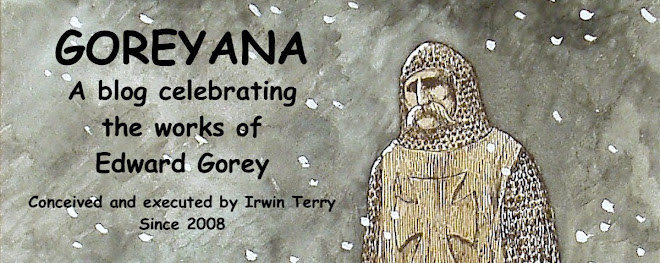
In previous blog entries regarding the prints of Edward Gorey, I have discussed prints made from existing artwork where little or no direct involvement of the artist occurred other than approving and signing the printed images. As we move into fine art prints created by Edward Gorey through the process of etching and collagraphs, the artist (Mr. Gorey) is directly involved in the image making process which results in the final set of prints. These images cannot exist in any other medium because they are a direct result of the process used to create them.

In pure etching, a metal (usually copper, zinc or steel) plate is covered with a waxy ground which is resistant to acid. The artist then scratches off the ground with a pointed etching needle where he wants a line to appear in the finished piece, so exposing the bare metal. The plate is then dipped in a bath of acid, or has acid washed over it. The acid "bites" into the metal, where it is exposed, leaving behind lines sunk into the plate. Once satisfied with the quality of the lines which are now permanently etched onto the plate, the remaining waxy ground is cleaned off the plate.
The artist may now subject the plate to this process again and again to alter the quality of line and tone larger areas of the plate through multiple acid/resist applications. Once the plate has been completed, the artist usually turns over the operation of printing the edition to a master printer (who is usually present throughout the entire process).

The plate is inked all over, and then the ink wiped off the surface, leaving only the ink in the etched lines and areas. The plate is then put through a high-pressure printing press together with a sheet of paper (often moistened to soften it). The paper picks up the ink from the etched lines, making a print. The plate can be printed many times; typically several hundred impressions (copies) could be printed before the plate shows much sign of wear (each impression requires a new layer of ink to be applied). This is a technique which has been used for hundreds of years by artists. Rembrandt Van Rijn (1606 - 1669) is one the most famous artists to embrace etching as an artist technique.

The official list of fine art etchings and collagraphs created by Edward Gorey includes 65 prints made during his lifetime and 17 "posthumous" prints. The posthumous prints are images printed from plates which Edward Gorey completed, but had not yet printed.

Edward Gorey's first set of etchings were distributed by Diogenes Verlag in 1978. The six images were each printed in an edition of 120 signed/numbered impressions. An additional set of twenty impressions were made of each image, each numbered with a Roman Numeral. All prints from this set were hand signed and numbered by Mr. Gorey. While these prints were always sold individually, they can be considered a set of six images.
The images include:
1 - Insect on Unicycle - I am showing print #15/120, above left
2 - Girl with Gymnasium Friend (shown at top of posting, not in my collection)
3 - Baby Transported - I am showing #119/120, bottom of post
4 - Malocclusion (Teddy Bear on Cliff) - I am showing print #71/120, above right - This is one of my all time favorite Gorey images. "Malocclusion" means crooked or irregular teeth.
5 - Woman Beneath Rolling Elephant (shown small above right, not in my collection)
6 - Child and Elephant Table (shown small above left, not in my collection) - According to research done by Rick Jones, director of the Edward Gorey House, the common title for this print,
Baby Seated Under Rolling Elephant is incorrect. The correct title appears in the original Diogenes brochure for the set of prints.
These six prints can be fairly difficult to acquire, and consequently tend to be somewhat expensive.
 The Bell, the Book and the Spellbinder by Brad Strickland was published by Dial Books for Young Readers in 1997. Mr. Strickland is pretty much "on his own" at this point in the John Bellairs' book series, but the basic premise for this story was founded on a comment Mr. Bellairs once made to a publisher about an enchanted/magic book that enslaves its reader.
The Bell, the Book and the Spellbinder by Brad Strickland was published by Dial Books for Young Readers in 1997. Mr. Strickland is pretty much "on his own" at this point in the John Bellairs' book series, but the basic premise for this story was founded on a comment Mr. Bellairs once made to a publisher about an enchanted/magic book that enslaves its reader. Mr. Gorey also created a frontis illustration and several small interior spot illustrations. The frontis drawing may just be his most disturbing illustration from the entire series, and possibly his career. It shows a deceased, dry mouse who still has the power to move due to magic. As the mouse tries to move, it begins to pull itself apart.
Mr. Gorey also created a frontis illustration and several small interior spot illustrations. The frontis drawing may just be his most disturbing illustration from the entire series, and possibly his career. It shows a deceased, dry mouse who still has the power to move due to magic. As the mouse tries to move, it begins to pull itself apart.


















